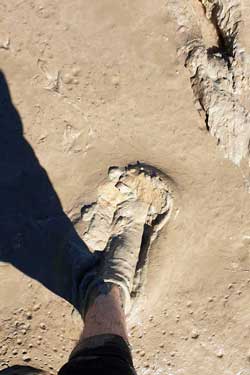Current Flows
A look at the current flows along key rivers

The upper Condamine runs along the border ranges and the water rises and falls in a fairly consistent manner along this stretch. So this would be the most important section to stay with the high flows. Previous floods suggest about a week of flowing waters, but as it is 426 km between Warwick and Chinchilla, it would be a stretch to paddle this section in 7 days (60 km / day)!
Below Chinchilla you should slowly catch up with the flow as you make your way down to St George (475 km away) with the flood waters travelling about 35 km / day, and easily catch it by Weilmoringle (350 km from St George) or Bourke (590 km from St George) as the waters flow slows to around ~25 km / day in the Culgoa.
While the Condamine River catchment is large, most of the flow into the Darling will be from the Barwon River with catchments along the western side of the Great Dividing Range from Sydney to QLD. From Bourke, you will likely be ahead of the flood waters from the Condamine, but if there is any flow, you shouldn't have any issues in the downstream section. With a widespread flood event, you will likely be meeting flood waters from the Barwon.
Bourke to Menindee is just under 1,000 km and flow is likely to take about 6 to 8 weeks (20 km / day), two weeks to Wilcannia, two more weeks to Menindee at 30 km / day.
From the flows seen this year, there is a remarkable predictability of the flow down the river in a flood event. From Bourke (22 Feb), the water took 4 days to reach Louth, 3 days 13 hrs more for Tilpa, 6 days 9 hrs more to Wilcannia and started filling Lake Wetherell 4 days 20 hrs later. The second rain event happened when there was water still flowing in the system and the flow peak speed increased slightly as shown in the table below. The other flow event that was looked at was from 2003 and was slower (smaller rain event).
| Town | Distance From Bourke | Days taken (Speed) | ||
|---|---|---|---|---|
| Dry Flow 2003 | Dry Flow 2020 | Wet Flow 2020 | ||
| Louth | 205 km | 5 days 8 hrs (1.6 km/h) 38.5 km per day |
4 days (2.1 km/h) 51 km per day |
2 days 15 hrs (3.3 km/h) 78 km per day |
| Tilpa | 373 km 168 km from Louth |
4 days 7 hrs (1.6 km/h) 39 km per day |
3 days 13 hrs (2 km/h) 47.5 km per day |
3 days 13 hrs (2 km/h) 47.5 km per day |
| Wilcannia | 644 km 271 km from Tilpa |
8 days 12 hrs (1.3 km/h) 32 km per day |
6 days 9 hrs (1.8 km/h) 42.5 km per day |
4 days 4 hrs (2.7 km/h) 65 km per day |
| Lake Wetherell | 922 km 278 km from Wilcannia |
5 days 8 hrs (1.6 km/h) 52 km per day |
4 days 20 hrs (2.4 km/h) 57.5 km per day |
undetermined |
So if you want to stay with the flow from a heavy rain event, you are looking at approx. 40 to 50 km days when dry and up to 65 km days when wet. However since the upper catchment area spans over 1,000 km between Sydney and Brisbane, the flow from any rain event is likely to last for weeks giving you plenty of time to enjoy the trip down without pushing long days. Also you have at least two weeks for the flow to drop under 10 Cumecs if the peak was above 5,000 ML/day. This gives 30 km days would be enough to enjoy high flows and even longer if you are happy to paddle flat water down.
Below Menindee, there should be a fairly slow continuous flow if the lakes are filled. This is under complete control of the MDBA. Refer to their weekly reports about the water releases, or lack of, within the system.
©2026 Alan Davison // Credit // Disclaimer